A judge has ruled that Google has unlawfully maintained a monopoly in search and text advertising, particularly through exclusive arrangements that made Google the default search engine on Android and Apple devices.
The decision marks a significant turning point in the search landscape. It’s possible that the specific remedies could pose a challenge Google’s long-held dominance in the market, which would have far-reaching implications for SEOs, advertisers, other tech companies, and the broader digital marketing industry.
The case is coming at a time when the search landscape itself is already in flux: many users now turn first to social platforms to search for information, while GenAI from Google itself and competitors like ChatGPT is set to play a significant role in the future of search.
It’s also only the first in a series of upcoming antitrust cases against giant tech companies, including a second case from the DOJ focused on Google’s ad tech and cases brought by the FTC against Amazon and Meta. But this case is the first to come to a conclusion; the decision may mark a shift in the federal government’s dealings with Silicon Valley, which have tended toward a hands-off approach in the past.
The judge has yet to announce the remedies in this first case, so the information we have at present is limited. One very possible outcome is that Google loses that lucrative default status in competitive browsers going forward, but the judge could go much further, which has fueled speculation that the courts could force a break-up of some of the tech giants that have defined much of our modern, digital-first life. We don’t think that’s likely, and it’s important to remember that any change will take some time; Google will almost certainly fully exhaust its options for appeals, which could take years.
As we wait to find out more about the decision and closely monitor the progress of the other cases, marketers need to focus on their main task, which isn’t about specific platforms: to meet customers where they are. If you are taking an audience-led approach, you can’t go wrong; in the meantime, keep testing new things and make sure your media mix is diverse enough that you’re not over-reliant on any one platform.
The competition: new search options giving Google a run for its money
While we wait for the final results of this landmark lawsuit, your brand should be getting ready for any potential changes that might impact your search strategy.
That doesn’t mean it’s time to abandon your Google strategy. The search giant will not disappear, regardless of the outcomes of these trials. Its extensive data ecosystem, advanced algorithms, investment in Gemini AI, and strong brand loyalty give it a significant competitive edge. Its entrenchment with current consumers also extends beyond the search engine alone; Google Chrome holds 65% browser market share, leading the pack by a wide margin compared to Apple’s Safari at 18% and Microsoft Edge at 5%.
But you need to start taking a close look at the other options in the search landscape that could start edging in on Google’s territory–or have already captured market share from the giant. You should get a robust testing strategy in place if you don’t already have one so you’re ready for whatever results come out of this case and any coming our way in the future.
OpenAI
OpenAI’s partnerships with Microsoft and Apple have already positioned the AI company as the most significant potential competitor as the industry tilts toward conversational AI-powered search.
Microsoft already directly integrates OpenAI’s cutting-edge AI models into its Bing search engine, as well as other products like the widely used Office 365 suite, the Edge web browser, and the Windows operating system. While Google still commands the lion’s share of the search engine market, Bing has been gaining ground: BrightEdge reports Bing’s market share has risen from 4.2% to 4.5% between 2023 and 2024.
On June 10, 2024, OpenAI and Apple announced that ChatGPT would be integrated into iOS, iPadOS, and macOS experiences so users can access the AI directly within Apple’s ecosystem. The move was widely seen as a hedge against a Google loss in this trial, reducing Apple’s dependence on the search engine. The integration includes advanced features like image and document understanding, enhancing Siri with ChatGPT’s intelligence to provide smart, contextually aware responses directly from Apple devices.
But OpenAI’s biggest, most direct foray into search happened in July, when OpenAI revealed its new SearchGPT prototype. That wasn’t a total surprise; Microsoft itself officially recognized OpenAI as a direct competitor in its latest annual report. But the potential of the new tool (and how exactly it will stack up against Google and Bing) is still a mystery, because it’s not yet available to the general public.
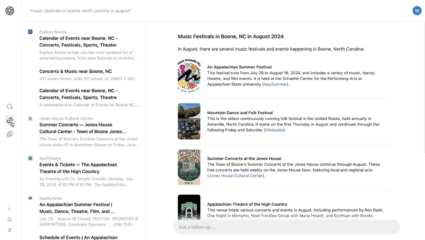
Source: OpenAI
AI search tools face some potential challenges of their own, including outstanding legal cases about copyright infringement based on the data used to train AI models and broader ethical concerns about consent and compensation. These issues have led many websites to block OpenAI crawl access, which severely hinders SearchGPT’s ability to collect up-to-date information and establish credibility by citing reputable sources.
Recent data shows that over 35% of the top 1000 websites are now blocking OpenAI’s GPTBot, reflecting growing resistance from web publishers against AI-powered crawlers. Major news publishers like The New York Times, CNN, and Reuters are among those blocking multiple AI crawlers.
While some brands are blocking full access, Open AI is doubling down on exclusivity, securing access to vast amounts of data to enhance their artificial intelligence models and power their conversational agents.
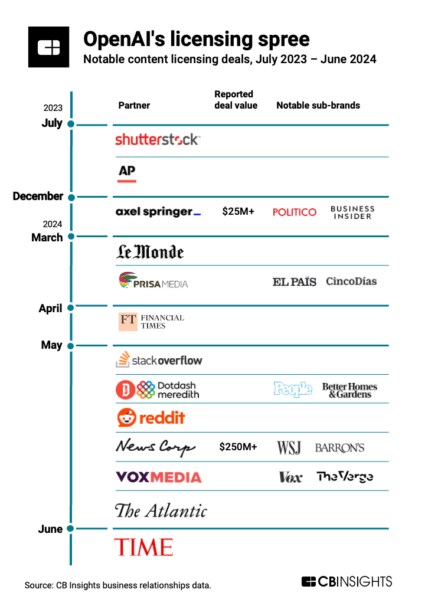
Source: CBS Insights
A lot hinges on how SearchGPT provides attribution and citations (links) as sources of its information. If this isn’t handled carefully, it could escalate existing tensions and lead to further restrictions from publishers.
Perplexity.ai
Although OpenAI dominates search partnerships, there’s another AI option in town: Perplexity.ai, which leverages advanced language models to deliver direct and contextually relevant answers to user queries, supplemented by search results from Bing and Google. The platform focuses on providing clear, concise responses and additional contextual information, prioritizing high-quality and authoritative sources.
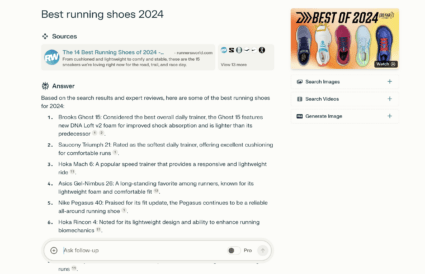
Source: Perplexity.ai
While it’s still a smaller player, Perplexity.ai is a search engine to watch; the platform has been rapidly gaining users and improving its features this year. Perplexity.ai’s organic traffic growth rate from May to June 2024 was above 30%, according to BrightEdge, but it won’t be toppling Bing or Google when it comes to search engine dominance anytime soon.
Social search
Many users are turning more and more to social platforms to search: YouTube, Reddit, and TikTok have emerged as particularly important to the customer journey. The results from social searches surface content from accounts that run the gamut across brands, influencers, and everyday users; authoritative search results aren’t necessarily what users are there for–it’s often more focused on getting perspectives from trusted creators and communities.
On platforms like YouTube, TikTok, and Instagram, those results tend toward the video or the visual. Google has also added many of those components to its own SERP and partners with many of the top social platforms. Notably, they have struck a deal with Reddit to use content from the platform to train its AI models like Gemini.
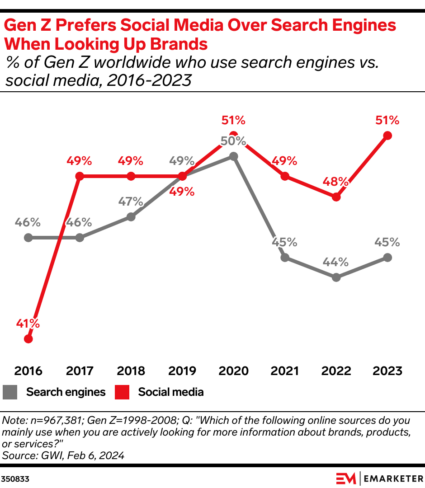
Source: eMarketer
Gen Z is particularly drawn to social search. According to a study from Adobe, over 60% of Gen Zers have used TikTok as a search engine, compared to almost half of millennials and a third of Gen Xers. eMarketer found that 59% of Gen Zers named YouTube as their top choice for search, with TikTok and Instagram taking second and third place.
The new rules: adapting your content to a changing world of search
As the search landscape continues to evolve in the long term, you will need to adapt your content strategy to cater to multiple search platforms and AI bots. You’ll also need to consider how social platforms are surfacing content; social search is still in its infancy, but it won’t necessarily follow the same rules as traditional SEO.
There is one rule that should lead all of this work: build helpful content.
Whether you’re working with a creator to produce a TikTok video or building a blog post for your own site, you need to create content that’s focused on helping people. Show them how to solve a particular problem, complete a task, or do something new that aligns with both your brand and their own interests. That can include guides, how-to tips, and easily digestible content that answers common questions or solves problems. Your goal is to deliver value at every touchpoint.
This will not only improve your rankings in Google’s traditional SERPs and its newer AI Overviews feature but also ensure that other search engines, AI bots, and social platforms can easily access and understand your content.
When it comes to SEO on your site, you’re in luck as you test into new platforms: most search platforms use similar models for determining relevance and ranking, so you can optimize your strategy for multiple platforms by following the same rules when it comes to content:
- Use citations and links: When you can, add citations and link to external sources and research to enhance your credibility and provide additional context. This will also help build trust with your audience.
- Regular updates: Make sure you’re regularly updating your evergreen pages so users can get the latest information. Keeping content current improves its relevance and search engine ranking.
- Implement schema markup: Using schema markup in HTML improves bot interpretation of content and entity relationships. Structured data acts as a translator between your content and search engines so your content can be found and presented effectively to attract and inform users.
- Make your site architecture crawl-friendly: Implement a clear hierarchical organization, where content is structured from broad categories to specific topics, to enhance your crawlability and discoverability.
- Build inbound authority: Boost your site’s search engine value by securing authoritative backlinks from reputable sources via outreach, digital PR, and social media. To get started, collaborate with influencers, maintain an active presence on platforms like LinkedIn, YouTube, Reddit, and TikTok, and aim for mentions from journalists in relevant publications.
Keeping track: monitor bots, browsers, and user behavior on your site
In a new world where Google won’t necessarily be the default browser on devices, you need to monitor your data to make sure you’re positioned to succeed, especially if the market opens up and consumers start exploring more search tools.
That starts with bots: you should keep a close eye on bot traffic to make sure your website is effectively crawled, indexed, and presented in search results across various platforms. Understanding which bots and AI agents are most prevalent can help you identify opportunities for direct partnerships, particularly with smaller, specialized agents. Most web analytics tools have built-in bot filtering or can be configured to track specific bots so you can get insights into pages crawled, time spent, and other bot behaviors.
You should also take note of the browsers your audience is using. In Google Analytics 4, you can see how many people use Chrome, Safari, Edge, or other browsers to get to your site or app by checking “Browser” and “Browser and OS” reports.
Finally, you need to know where organic traffic and AI-agent referrals are coming from so you can identify patterns and get ahead of any breakout traffic sources for your brand. For example, if your website starts to see a significant increase in traffic from Bing search, you should brush up on how Bing ranking factors differ from those of other platforms and make sure your SEO strategy is effectively optimizing content for that search engine, not just Google.
Whatever remedy the judge ends up imposing, advertisers will be faced with new challenges and opportunities in the wake of this trial. Preparation can mean the difference between success and failure.






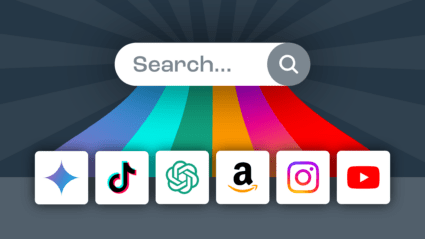
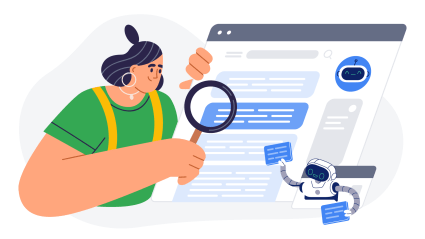
Responses